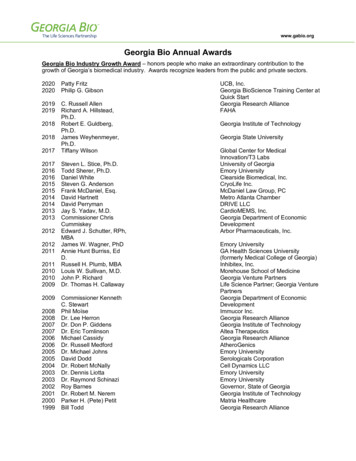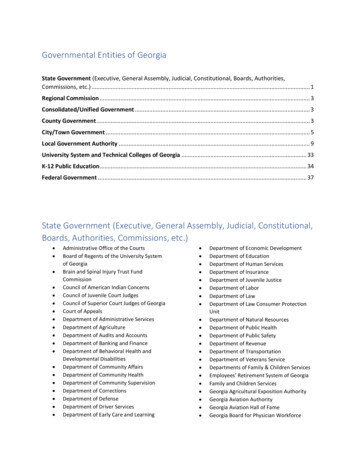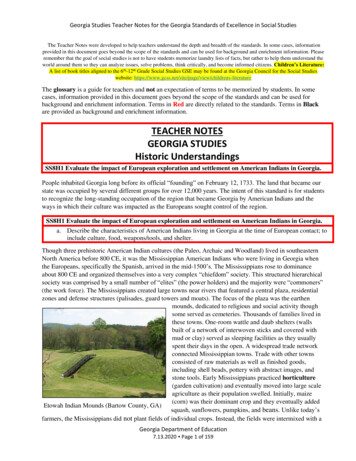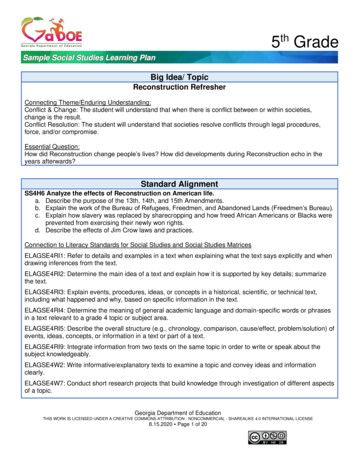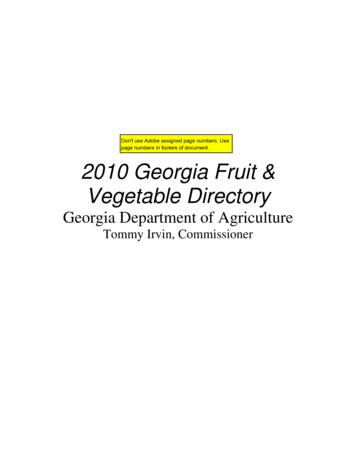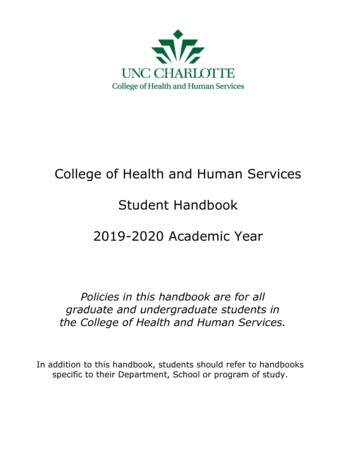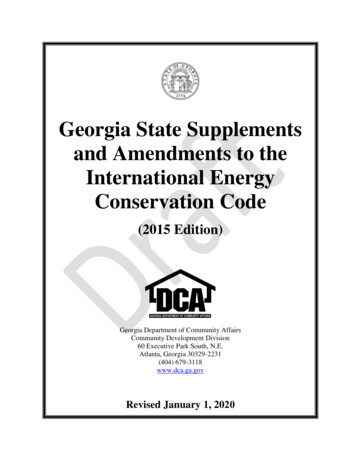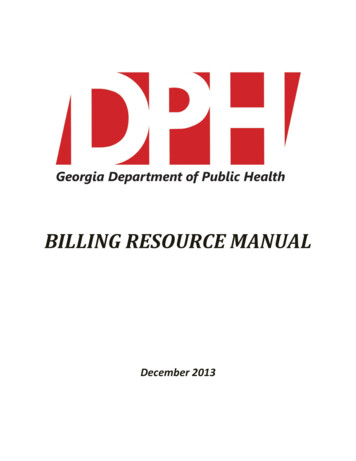
Transcription
BILLING RESOURCE MANUALDecember 2013
Public Health Billing Resource ManualDecember 2013PREFACEThe Public Health Billing Resource Manual provides policy & procedural guidance onhow to bill 3rd party payers for public health programs and services. Developed as a billingresource tool; its purpose is to assist state, district and county public health staff inunderstanding the insurance coding and billing process.Part I-The Policies and Procedures section focuses on the terms and conditions of billingand reimbursement from 3rd party payers. It provides guidance on eligibility & verification,coordination of benefits and billing procedures to avoid delays in reimbursement.Part II-The Billing & Coding: Methodologies & Rates section emphasizes the importanceof the clinical components of CPT coding to ensure 3rd party payers are charged at theappropriate level of service delivery and reimbursement.The Appendices section includes Related Links, Billing Contact Information, Acronyms,Definitions, and other resources used in mastering the reimbursement process.Amendments are made quarterly in accordance with policy changes in federal and statelaws.Disclaimer: Contract Provisions between DPH and 3rd Party Private Payers containconfidential and proprietary information that prohibits dissemination, distribution ordisclosure of reimbursement rates to any parties other than county Boards of Health andDPH employees. These reimbursement rates are dispersed to appropriate DPH staffthrough the Department email system.Currently, Georgia DPH is contracted with the following 3rd Party Payers for ImmunizationServices:Medicaid Fee-For-Service (FFS);Peach Care for Kids (PCK);CMOs: PeachState, Wellcare, and Amerigroup;Medicare: CahabaState Health Benefit Plan (SHBP): UHC & Cigna;BCBS of GA: PPO-Federal Employees Plan (FEP); Open Access HMO; Open Access Pointof Service; Board of Regents/University System EmployeesAETNA: PPO; HMO; Point of Service; Open Access; Medicare AdvantageNote: Medicaid, PCK, CMOs, and Medicare are accepted for other services, i.e., Health Check,Family Planning, Adult Health, etc. in most of our county health departments.Preface i
Public Health Billing Resource ManualDecember 2013TABLE OF CONTENTSPART IBILLING POLICIES & PROCEDURESSection 11.11.2IntroductionEnrollment ProcessSection 32.12.22.3IntroductionEligibility & VerificationWIC EligibilitySection 43.13.2IntroductionPrimary & Secondary PayersSubmission & Resubmission of Claims4.14.24.34.4IntroductionClaim RequirementsFiling Time LimitsAppeals ProcessSection 2PART IIProvider EnrollmentInsurance Eligibility & VerificationCoordination of BenefitsBILLING & CODING: METHODOLOGIES & RATESSection 5Section 6Table of ContentsImmunization h Check (HC)Diagnostic, Screening, & Preventive Services (DSPS)MedicareSHBP- UHCSHBP-CIGNABlue Cross Blue Shield (BCBS)AETNA6.16.26.36.46.56.6MethodologiesHC VisitsChildren’s Intervention Services (CIS)Early Intervention (EI) Case Management ServicesDSPSNurse Practitioner & Physician ServicesChild Health Services iii
Public Health Billing Resource ManualSection 7Women’s Health ServicesSection 8Adult Health ServicesDecember 20137.17.27.37.47.57.67.7MethodologiesFamily Planning (FP)Perinatal Case Management (PCM)Childbirth Education (CBE)Pregnancy Related Services (PRS)DSPSNurse Practitioner & Physician ServicesSection 98.1.8.28.38.4MethodologiesDSPSTargeted Case Management (TCM) for Adults w/ AIDSMedicare Preventive ServicesSection 109.19.2MethodologiesHealth Check/Adult/Pregnant WomenMiscellaneous ServicesSection 11AppendicesDental Services10.1 Self-pay Services11.111.211.311.411.5Table of ContentsComponent Requirements for Office & Home VisitsRelated LinksAcronyms & DefinitionsHealth Plans by RegionBilling Contact Information iv
Public Health Billing Resource ManualDecember 2013PART IBILLING POLICIES& PROCEDURESPart I Billing Policies & Procedures 1
Public Health Billing Resource ManualDecember 2013Section 1Provider Enrollment1.1 IntroductionProviders must be enrolled as a qualified provider with a 3rd party payer before they cansubmit claims for reimbursement. This section provides guidance on the EnrollmentProcess.1.2 Enrollment ProcessNew providers are now able to use the GHP’s Web Portal as a single source system tocomplete an electronic Georgia Medicaid enrollment and CMO credentialing. This systemwill collect and retain all required documentation needed for DCH and the CMOs to makean enrollment and/or credentialing determination AND allow new providers to uploadtheir credentialing documents into the system. A joint application was created to alleviateredundancy in submitting information to multiple organizations.Phase I of this ongoing project is for new providers that do not currently have an active andvalid Georgia Medicaid number. Current Providers that are applying for new servicelocations or re-credentialing, are not part of this phase. These providers will be included ina later phase. The scope of this project is for credentialing only. Contact the respectiveCMO directly to request a contract for network participationImportant factors for Providers to keep in mind during the enrollment process: Go to https://www.mmis.georgia.gov/portal/default.aspx to submit application and ALLsupporting documents including NPI confirmation letter and Tax ID information Complete all sections of the application The effective date on all documents should be within the required timeframe Respond promptly to any request for additional information or documents Each location where services are provided must be enrolled An Approval Notice with effective date of enrollment will be sent to Provider. If denied,notification explaining denial and the right to appeal is sent to Provider Federal regulations require that some Providers may have to pay an application feeprior to executing a provider agreement Providers must report any changes in information within 10 days to the EnrollmentUnit or submit the change request onlineSection 1 Provider Enrollment 2
Public Health Billing Resource ManualDecember 2013To be considered as an in-network provider, health departments identified as a “facility”must enter into a contractual agreement with 3rd party payers to provide a limited range ofservices to covered members.The Georgia Department of Public Health is contractually recognized by private plans as an“In-network Ancillary Provider.” An Ancillary Provider is the collective of state and countyentities that have been selected by a Plan for participation as a “Network Provider”, thathas signed an Ancillary Provider Agreement and that will provide only those servicesidentified in the Agreement.Health department services are provided by licensed physicians, nurse practitioners,registered and licensed nurses, social workers and dieticians who operate under the directsupervision of a Health Director/Physician, and within the scope of the physician’sextender’s licensure or certification and in accordance with the current approved writtenprotocol applicable to each of the aforementioned professions.The Provider Agreement also includes specific guidance on the Responsibilities,Reimbursement Rates and Claim Submission Processes that both parties must adhere to.State office staff, under the auspices of the Commissioner, submits health departmentprovider locations for all sites, provider numbers, tax ID, and NPI number to all privatepayers to load into their billing system and satisfy the provider enrollment terms of theAgreement.Information on Provider Enrollment for Medicare Part B can be found @https://www.cahabagba.com/part-b/Section 1 Provider Enrollment 3
Public Health Billing Resource ManualDecember 2013Section 2Insurance Eligibility & Verification2.1 IntroductionThe business of Public Health begins with clients seeking services at local county healthdepartments. This Section provides guidance on client intake and the steps required to obtaininsurance information for billable services rendered in public health.2.2 Eligibility & VerificationFrontline staff should brief clients on the intake process prior to receiving services. Aneffective intake process begins with a registration form that gathers vital information on theclient’s demographics, insurance coverage, and services requested. New Patients shouldcomplete a form at their first visit and Established Patients should complete one if they haveany changes in their information since their last visit. Verifying and updating this informationis critical at every visit.Important Steps that should be taken with every client at every visit: Copy the client’s primary and any secondary insurance cards Verify eligibility, policy status, effective date, type of plan and Exclusions Inform client of their responsibility for co-pays, coinsurances and deductibles Inform client of Waiver for non-covered services and payment optionsIt is the Providers responsibility to verify coverage before services are rendered. Failure to doso may result in non-payment of non-covered services and difficulties recouping payment fromthe client after services have been provided. “Active” coverage does not guaranteereimbursement for services listed on the Fee Schedule. Please refer to the client’s individualInsurance Plan/Exclusions to identify “Non-Covered” services.In order to charge clients for non-covered services, a Waiver for Non-Covered Services withthe following information must be provided to the client: Identify the service that is not covered Identify covered service that may be available in lieu of the non-covered service The cost of the service and payment arrangements The client must sign the Waiver indicating acceptance of the non-covered service andagreement to pay for the non-covered serviceMedicaid/CMO eligibility can be verified at https://www.mmis.georgia.gov/portal; CMO portals:PeachState http://www.pshpgeorgia.com/for-providers/; WellCare https://georgia.wellcare.com/provider;Amerigroup providers.amerigroup.com/pages/home.aspxSection 2 Insurance Eligibility & Verification 4
Public Health Billing Resource ManualDecember 2013Provider Discretion: It is a Provider’s discretion to accept a Medicaid member as a client.By accepting a Medicaid member as a client, the Provider1) Agrees to accept, as payment in full, the amount paid by Medicaid for all covered serviceswith the exception of co-pays and payments from 3rd party payers.2) Is prohibited from choosing specific procedures for which the Provider will acceptMedicaid, whereby the Medicaid client would be required to pay for one type of coveredservice and Medicaid to pay for another service if applicable.Failure to comply with these procedures will subject the Provider to sanctions, up to andincluding termination from the Medicaid Program.When a client is ready to check-out, the paystation collects any copayments, deductibles, andservice fees. Payment in full is expected at time of service. If a client is unable to pay, theclinical manager may make payment arrangements. The clinic manager should reinforce theBoard of Health’s billing policy and resolve the issue with the client through an agreedpayment plan.2.3 WIC EligibilityClients that come to the health department requesting WIC Services must provide proof ofincome for eligibility into the Program. Additional information and Income Guidelines can befound via the web @ http://dph.georgia.gov/WICSection 2 Insurance Eligibility & Verification 5
Public Health Billing Resource ManualDecember 2013Section 3Coordination of Benefits3.1 IntroductionBy federal law, Medicaid is the “payer of last resort” in most circumstances. Coordinationof Benefits (COB) is the process of determining the primary payer. This section will helpdefine the “payer of last resort” status when submitting claims for payment. To find outmore information on COB please refer to The Medicaid Secondary Claims User Guide @www.mmis.georgia.gov under Provider Manuals.3.2 Primary & Secondary PayersA third party resource is an individual, entity, or program that is or may be liable to pay forall or part of the expenses for medical care provided to a Medicaid client. COB regulationsrequire that all health plans coordinate benefits to eliminate duplication of payment andensure clients receive the maximum benefits they are entitled to. Medicaid will considerpayment of a claim only after all other 3rd party resources have been exhausted.EXCEPTIONS: In accordance with federal regulations, a Provider does not have to exhaustother health plan benefits with respect to: a) Non-institutionalized pregnancy relatedclaims; b) Claims for preventive and pediatric services including Health Check.Filing a Medicaid COB Claim: When a client has other coverage that is potentially liable forpayment of a claim, a COB claim is required prior to billing Medicaid. A COB claim submitted toMedicaid will be processed in one of two ways:1. Cost-avoid: A Provider must bill the primary payer before billing Medicaid. Medicaidwill pay the claim once the primary payer processing information is included on the claim.2. Pay-and-chase: Medicaid will pay for the services and then attempt to recover from theliable 3rd party. If Medicaid pays for these services, the Provider cannot bill the 3rd partypayer.When the liability of a 3rd party cannot be established or is not available to pay for theclient's services within an applicable timeframe, Medicaid will reimburse the Provider forcovered services in accordance with standard reimbursement procedures.Crossover Claims: A Medicare crossover claim is any claim that is approved by Medicareand then sent to Medicaid for consideration of payment not to exceed the sum of theMedicare deductible, co pay, or coinsurance.Section 3 Coordination of Benefits 6
December 2013Public Health Billing Resource ManualThe claim must be approved by Medicare in order to be considered a crossover claim.“Approved” does not mean paid; sometimes the charges approved by Medicare are appliedto the deductible. In these situations, the claim is approved, but no payment is made byMedicare.It is important to remember that claims that are denied by Medicare are notcrossover claims. If a member is a Qualified Medicare Beneficiary (QMB) and Medicaredenies the claim, do not bill Medicaid.The receipt of a crossover claim by Medicaid does not mean that Medicaid will make apayment on the claim. If Medicaid approves the claim, a payment of the sum of thecoinsurance and deductible may be made. If the Medicare payment on a claim is equal to orgreater than the Medicaid maximum allowable amount, Medicaid will not pay anything onthe claim, but the claim will still be a paid Medicaid claim.NOTE: For QMB members, Medicaid will be reimbursed payments for the Medicarecoinsurance, deductible, and HMO Sub Copay amounts, less applicable 3rd party liabilitiesand patient Medicaid co-pays.WHAT IF the Medicaid Member is also eligible for Medicare?SERVICE BY MEDICAID PROGRAMHealth Check/ImmunizationFamily PlanningPerinatal Case Management/PregnancyRelated ServicesDental Services (Health Check, Adult)Adult Services/ImmunizationsNurse Practitioner/Physician ServicesMEDICAREDoes not CoverDoes not CoverMEDICAIDPrimary PayerPrimary PayerDoes not CoverPrimary PayerDoes not CoverPrimary Payer-Flu, Pneumonia, Hep B; MNT;Preventive ServicesPrimary PayerPrimary PayerSecondary PayerSecondary PayerWHAT IF the Medicaid Member is also eligible for other private insurance coverage?SERVICE BY MEDICAID PROGRAMHealth Check/ImmunizationsPerinatal Case Management/Pregnancy Related ServicesFamily PlanningAdult Services/ImmunizationsNurse Practitioner/Physician ServicesDental Services (Health Check, Adult)Section 3 Coordination of BenefitsPRIVATE INSURANCEMEDICAIDN/APrimary PayerN/APrimary PayerCOB REQUIREDCOB REQUIREDCOB REQUIREDCOB REQUIRED 7
Public Health Billing Resource ManualDecember 2013The following tips will assist Providers in reducing payment delays attributed to COBrelated problems:1.2.3.Ask All Patients about Secondary Insurance Coverage. Collect and confirm primaryand secondary insurance information at each visit.Know What Plans and Payers Need to Pay Claims. Nearly all plans require a copy ofthe Explanation of Benefits (EOB) from the primary payer prior to paying a claim asthe secondary payer. Most plans and payers publish their requirements and theinformation should be available in provider manuals, online, and by contactingphysician/provider representatives.Primary & Secondary Payers: The following rules are used determine the primaryand secondary payer: a) The payer covering the patient as a subscriber will be theprimary payer. b) If the patient is a dependent child, the payer whose subscriber hasthe earlier birthday in the calendar year will be the primary payer. This is known asthe Birthday Rule.Section 3 Coordination of Benefits 8
Public Health Billing Resource ManualDecember 2013Section 4Claim Submission / Resubmission4.1 IntroductionThe Submission & Resubmission of Claims focuses on the importance of converting clinicalservices provided to a client into billable claims and submitting them via an Electronic DataInterchange to 3rd party payers for reimbursement. To receive proper payment forservices, public health billing staff must collect accurate information required to submit aCMS 1500 insurance form correctly.4.2 Claim RequirementsProviders must take all reasonable measures to determine a 3rd Party Payer’s liability forcovered services prior to filing a Medicaid claim. If a 3rd party insurance plan denies orpays insufficiently the applicable reimbursement rate, a Provider may submit a claim to bepaid the applicable reimbursement rate minus any reimbursement received from otherresources. These claims must be billed to Medicaid within 3 months of the date of thedenial/payment but not more than 12 months from the date of service. Claims that do notgenerate a response from the carrier may be filed with Medicaid using the COB NotificationForm DMA-410, indicating no response was received.Failure to file a claim within six months after a service is rendered and/or failure to obtaina required prior approval or precertification will result in a denial of that claim. Obtainingprior approval or precertification does not guarantee payment of a claim.If a Provider believes a negative adjustment is appropriate, the Provider may adjust andresubmit a claim. This can be done @ www.mmis.georgia.govA 3rd Party Payer may deny part or all of a claim for the following reasons: 1) The servicesare not covered; 2) The client was not eligible on the date of service; 3) The provider failedto obtain prior approval or precertification for the required services; or, 4) The servicesprovided have been determined to be medically unnecessary.Federal law prohibits State payments for Medicaid services to anyone other than aprovider, except in specified circumstances. Expressly prohibited are payments tocollection agencies working on a percentage or other basis unrelated to the cost ofprocessing the billing.Section 4 Submission & Resubmission 9
Public Health Billing Resource ManualDecember 20134.3 Filing Time LimitsAmerigroup.PeachStateSubmission: 6 months to submit clean claimsAppeals/Payment Disputes: 30 calendar days of the adjudication date of the EOP.Submission: 6 months to submit clean claims.Resubmission: The claim must clearly be marked as “RESUBMISSION” and include the original claimnumber within 45 days following initial filing; Failure to mark the claim as a resubmission and include the claimnumber or EOP may result in the claim being denied as a duplicate, or exceeding the filing limit deadline.Appeals/Payment Disputes: 30 calendar days of the adjudication date of the EOP.WellcareSubmission of claims: 6 months from the date of service.Appeals/Payment Disputes: 90 calendar days of the adjudication date of the EOB.MedicaidSubmission: 6 months after the date of service.Appeals/Payment Disputes: Within 3 months of the month in which the denial occurred.MedicareCignaUHCBCBSAETNASubmission: Claims must be received within1 calendar year from the date of service.Appeals/Reconsiderations: Must be submitted within 6 months of the date on the notice of redeterminationletter.Submission: 6 months after the date of service.Appeals/Payment Disputes: Appeals must be submitted in writing within 6 months of the date of the initialpayment or denial notice or, if the appeal relates to a payment that was adjusted by CIGNA HealthCare, within6 months from the date of the last payment adjustment.Submission: 6 months from the date of service.Resubmission: 45 days after original submission.Appeals/Payment Disputes: Request Claim Reconsideration. Appeals must be submitted within 12 monthsfrom the date of the Explanation of Benefits (EOB) or Provider Remittance Advice (PRA).Submission: 3 months from date of service.Resubmission: 2 months after original submission.Appeals/Payment Disputes: Documentation including cover letter outlining issue. 10 pages or less can befaxed to 877-868-7950; More than 10 pages can be mailed to BCBSGa, Attn: Provider Appeals, P.O. Box9907, Columbus, GA 31908.Submission: 6 months from date of service.Resubmission: 45 days after original submission.Appeals/Payment Disputes: 6 months from date of last payment adjustment.4.4 Appeals ProcessEvery health insurance company has a grievance and appeal procedure defined in itspolicy. You can appeal a 3rd party payer’s decision to deny a claim or pay less than theamount billed. Please refer to the appropriate payer’s website for instructions on to appeala claim.The 3rd party payer may still deny a claim based on medical necessity despite pre-approvaland a correctly coded claim. Appeal requests that do not contain sufficient information willnot be processed.Section 4 Submission & Resubmission 10
Public Health Billing Resource ManualDecember 2013PART IIBILLING & CODING:METHODOLOGIES &RATESPART II METHODOLOGIES & RATES 11
Public Health Billing Resource ManualDecember 2013Section 5Immunization Services5.1 MethodologiesThe following guidance will allow for successful billing and maximum reimbursement ofImmunization Services. Information on the GA Immunization Program’s Eligibility Criteria for vaccines can befound @ zations/Oct2013-Eligtable 0.pdf Uninsured/Underinsured clients, 18 years, may be eligible for VFC vaccines throughthe HC Program. The HC Program will reimburse the cost of the vaccine (private stock)and the admin code for patients 19-20 years (The EP Modifier must be used).Uninsured/Underinsured clients, 21 years, may be eligible for State Supplied vaccinesthrough the DSPS Program. The P4HB Waiver will reimburse for Tdap & Hep B (county purchased) to 18-20 yrs. Please refer to Health Check Manual @ www.mmis.georgia.gov under Provider Manualsfor the DCH VFC Vaccine Administration Fee policy and the Peachcare Rate differential. If no other E/M service is provided on the same day, a 99211 at the maximum allowableamount of 17.46, can be billed with State supplied vaccines that are not reimbursableby Medicaid. (Medicaid will deny the vaccine but should pay the office visit) The Medicare Direct Plan is the primary payer for immunizations provided to SHBP UHC& CIGNA retirees. The Claim address is on the back of the member’s ID card. Local health departments are recognized as Ancillary Providers for BCBS. BCBS willreimburse for immunization services provided to members from other states and federalemployees that have BCBS PPO and HMO coverage. Providers may not charge or seek reimbursement from a BCBS or AETNA Plan memberfor covered services. This does not prohibit the collection of copayments, coinsurance,and deductibles. For non-covered services, providers will inform the client of theWaiver for non-covered services. Clinics must use place of service Code 03 for Flu vaccine administered to Medicaid/CMOchildren at school-based flu clinics.Section 5 Immunization Services 12
December 2013Public Health Billing Resource Manual5.2 EPSDTAges Birth up to 19 yearsService DescriptionCPT CodeModifierICD-9 DXRate2013 3.9V03.9V03.9 10.00 10.00 10.00 10.00 V06.1V05.4V06.8V03.82V03.89V05.3V06.8 2.99 0.00 0.00 0.00 0.00 0.00 0.00 0.00 0.00 0.00 0.00 0.00 0.00 0.00 0.00 0.00 0.00 0.00 0.00 0.00 0.00 0.00 0.00 0.00 0.00 0.00 0.00 0.00 2.231.932.880.711.70Age RestrictionVaccine AdministrationImmunization Admin, 1st or only componentImmunization Admin, singleImmunization Admin, each add. componentImmunization Admin, intranasal or oralImmunization Admin, each add./multipleVaccines – VFC SuppliedTuberculin Skin TestHep A, 2 doseHep A, 3 doseHIB, Hemophilus b conjugate, 3 dose (Pedvax)HIB, Hemophilus b conjugate (ACTHIB), 4 doseHPV, Human Papilloma Virus (Gardasil)Influenza, preservative free (Fluzone)Influenza, preservative free (Fluzone)Influenza, (Fluzone)InfluenzaPneumococcal conjugate 13 Valent (Prevnar 13)Influenza, quadrivalent ,live, intranasal use (Flumist)Rotavirus Vaccine, 3 dose, live (RotaTeq)Rotavirus Vaccine, 2 dose, live (Rotarix)Influenza, quadrivalent (Fluarix)DTaP-IPV, BoosterDTaP-Hib-IPV (Pentacel)DTaP, Diphtheria, tetanus, pertusisMMR, Measles, Mumps, RubellaMMRV, Measles, Mumps, Rubella, VaricellaIPV, Inactivated Polio (IPOL)Td, Tetanus, diphtheria toxoid, preservative freeTdap, Tetanus, diphtheria toxoid & pertusisVaricellaDTaP-Hep B-IPV (Pediarix)Pneumococcal 23-Valent (Pneumovax 23)Meningococcal conjugateHep B (Engerix-B)Hep B-Hib (COMVAX)Section 5 Immunization Services9-18yrs6-35mths3-18yrs6-35mths3-18yrs 5 yrs2-18yrs6mths-6yrs3-18yrs4-6yrs6wks-5yrs7yrs & 2-18yrs 13
December 2013Public Health Billing Resource Manual5.2 EPSDTAges 19 to 20 yearsService DescriptionCPT CodeModifierICD-9 DXRate2013 9 10.00 10.00 10.00 .81V06.4V06.5V06.1V05.4V03.82V03.89V05.3V05.3 50.93 95.69 144.93 12.40 24.60 19.41 57.34 19.93 33.35 96.57 65.77 113.60 59.71 2.880.711.70Vaccine AdministrationImmunization Admin, 1st or only componentImmunization Admin, each add. componentImmunization Admin, intranasal or oralImmunization Admin, each add./multipleVaccines – County SuppliedHep A, 2 doseHep A-Hep B (Twinrix)HPV, Human Papilloma Virus (Gardasil)Influenza, preservative free (Fluzone)Influenza, quadrivalent ,live, intranasal use (Flumist)Influenza, quadrivalent (Fluarix)MMR, Measles, Mumps, RubellaTd, Tetanus, diphtheria toxoid, preservative freeTdap, Tetanus, diphtheria toxoid & pertusisVaricellaPneumococcal 23-Valent (Pneumovax 23)Meningococcal conjugateHep B, 3 dose scheduleHep B, 4 dose, dialysis or immunosuppressedSection 5 Immunization Services 14
December 2013Public Health Billing Resource Manual5.3 DSPSAges 21 years & olderService DescriptionCPT CodeICD-9 DXRate2013 RVU99211V03.9 89V05.8V06.8V05.8 2.99 95.69 144.53 18.98 12.40 16.45 24.60 19.41 39.16 57.34 29.16 33.35 96.57 19.93 65.77 106.49 113.60 170.15 119.42 0.982.230.591.933.132.884.863.513.51Age RestrictionVaccine AdministrationImmunization Admin, 1 per visitVaccines - County SuppliedTB Skin TestHep A-Hep B (Twinrix)HPV, Human Papilloma Virus (Gardasil)Influenza, IntradermalInfluenza, preservative freeInfluenzaInfluenza, quadrivalent ,live, intranasal use (Flumist)Influenza, quadrivalent (Fluarix)DT, Diphtheria, tetanus toxoidMMR, Measles, Mumps, RubellaIPV, Inactivated PolioTdap, Tetanus, diphtheria toxoid & pertusisVaricellaTd, Tetanus, diphtheria toxoid, preservative freePneumococcalMeningococcal polysaccharide (Menomune)Meningococcal conjugate (Menactra, Menveo)Zoster (shingles) live (Zostavax)Hep B, dialysis or ImmunosuppressedHep B, dialysis or Immunosuppressed 6907409074721yrs18-64yrs 7yrs 19yrs7-55yrs21-55yrs 60yrsMedicaid Members 21 years and older may be eligible for State Supplied VaccinesClients with Medicaid that does not cover vaccinations are considered underinsured and may be eligible for 317 fundedvaccines. They must meet the Age Requirements below and Eligibility Criteria to qualify for state supplied vaccines.Note: State supplied Tdap is available for Medicaid members 56 years and older or until they are covered by MedicarePart D Plan.Service DescriptionCPT CodeICD-9 DXRate2013 RVUAge .3 0.00 0.00 0.00 0.001.503.850.981.75 21yrs22-26ys 56yrs 21yrsVaccines – State SuppliedHep AHPVTdapHep BSection 5 Immunization Services 15
December 2013Public Health Billing Resource Manual5.4 Medicare – Part BService DescriptionCPT CodeICD-9 DX001 / 099 Rate2013 RVUG0008G0009G0010V04.81V03.82V05.3 24.41 / 22.30 24.41 / 22.30 24.41 / 1V04.81V04.81V04.81V04.81V04.81V03.82V05.3 18.92 17.
New providers are now able to use the GHP’s Web Portal as a single source system to complete an electronic Georgia Medicaid enrollment and CMO credentialing. This system will collect and retain all required documentation needed for DCH and the CMOs to make an enrollment and/or credentialing determ

